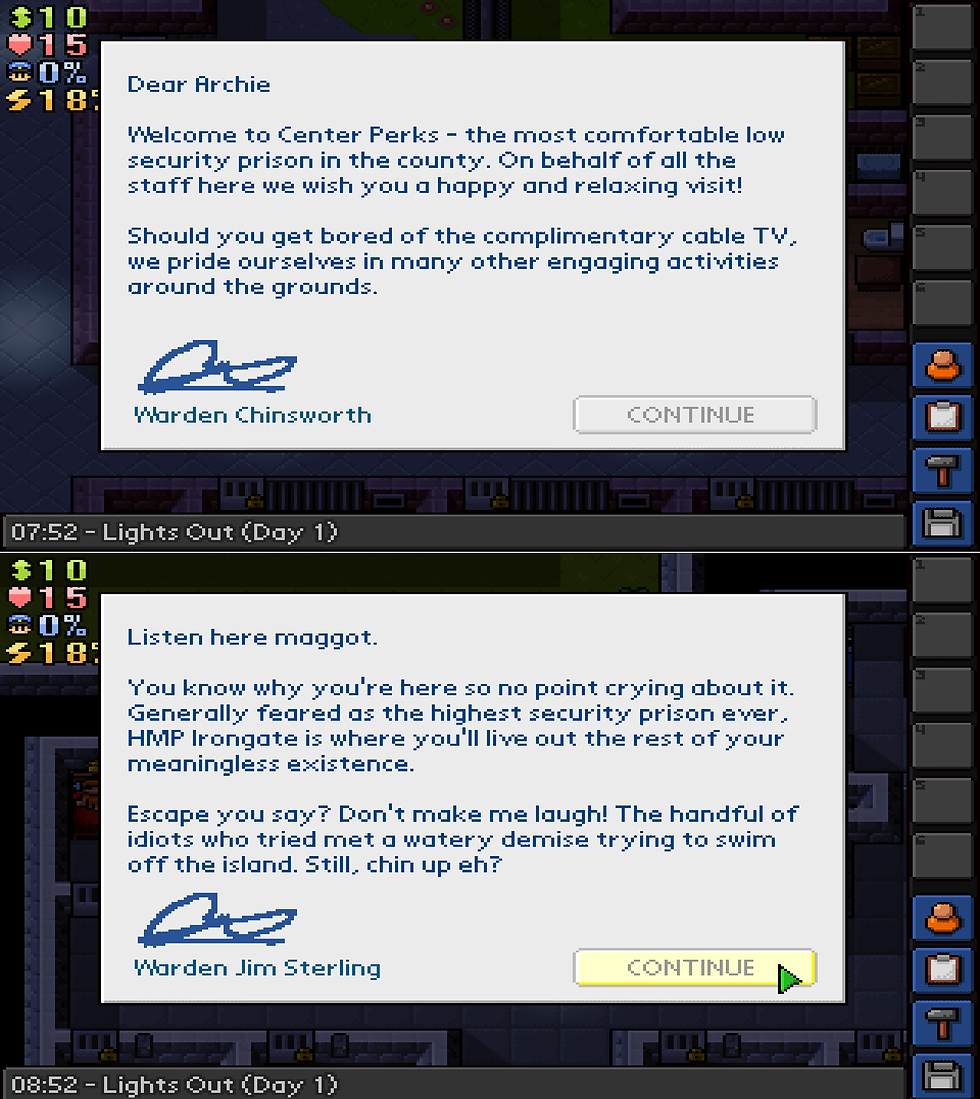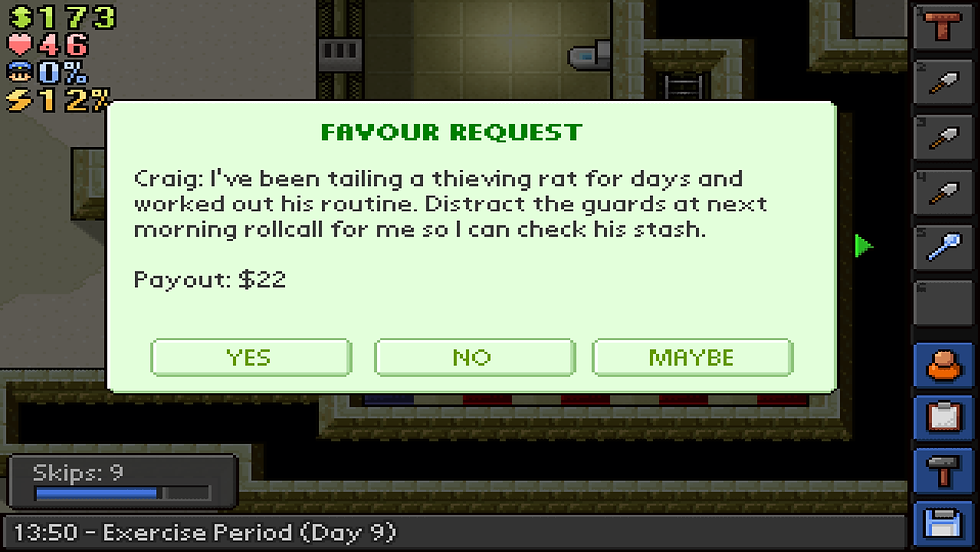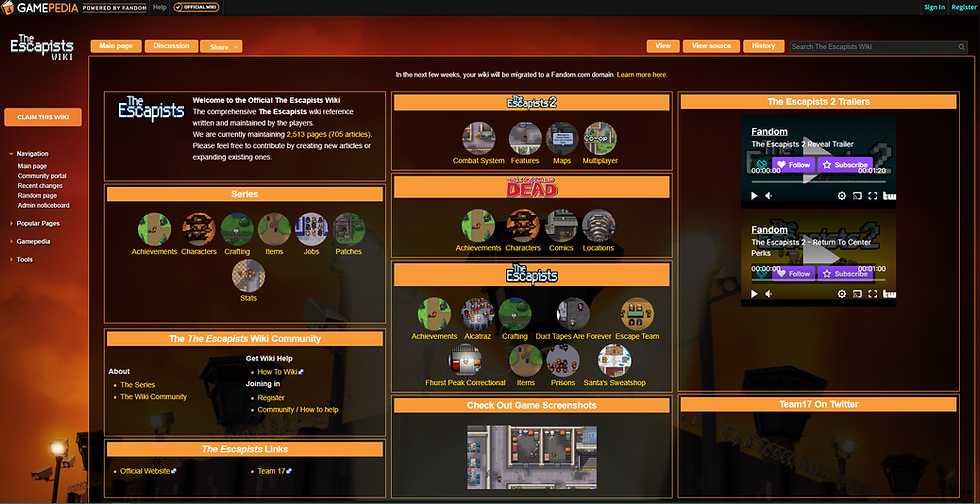
Developer: Mouldy Toof Publisher: Team17 Release year: 2015
Spoilers: None Reviewed on: PC
Every story requires a setting for the narrative to take shape, and The Escapists is all about the prison setting – specifically how to breakout. This sandbox strategy-puzzle game rewards creativity as the player collects craft items, attempts to keep the guards off their backs and plans their getaway…which get progressively tougher. Whilst this game isn’t overtly focused on a plot, there are narrative components developed by Mouldy Toof that maintain the player immersion, explain the game mechanics and indicate level progression.
Mouldy Toof utilise emergent and enacted narrative to drive the progression of the game: emergent describes the influence of player decisions in the unfolding narrative, whilst enacted refers to the development or ‘levelling-up’ characteristics of the player’s in-game character (Salen, 2003). This is a good approach for the game style; it provides the player with the freedom to be inventive with problem-solving whilst also creating limitations that, when are worked around, offer a sense of reward.
The narrative of The Escapists is primarily delivered through notes and dialogue, both of which indicate prison difficulty levels as well as shifting NPC-PC relations. This is a clever use of narrative, and adds humour to a game that can become reliant on the ‘daily grind’. For example, ‘Center Perks’ (the first prison) has a pleasant welcome message compared to the hardest prison, ‘HMP Irongate’ (see below).

These welcome messages also hint at challenges the player may face beyond their cell. There are also a number of humorous pop-culture or gaming references sprinkled throughout the narrative: above we see ‘Warden Jim Sterling’, a games journalist; below are references to the catchy Kaiser Chiefs’ song and the popular Breaking Bad TV series.

Favours – or ‘quests’ in game terminology – form another narrative feature provided by fellow inmates, ranging from fetch-quests to orchestrating NPC beatings. The scripted colloquial dialogue maintains and develops the prison aesthetic and atmosphere; however, they are almost ‘too’ story-oriented, with not enough instruction. The below image illustrates the favour request to ‘distract the guards’, however, gives no further direction.

The tutorial has faced criticism for not giving enough instruction on interacting with the game mechanics. Perhaps expanding the tutorial would have been useful – for instance to explain how to complete the four quest types. On the other hand, the developers may have decided against this approach to encourage players to ‘learn-as-they-go’. Their current approach allows room for growth, creativity and improvisation as they try to avoid telling the player what to: unassisted problem-solving can create a higher sense of achievement. Their approach also helps build a community, sharing tips and tricks that creates further conversation around their game (see below The Escapists Wiki).

Another issue within the game’s narrative are the NPC-PC interactions: the dialogue becomes repetitious after many in-game days. Yet, in such a grind-centric game like The Escapists, it is almost impossible for the dialogue to escape becoming monotonous as well. It is clear the developers wrote many dialogue phrases – many comical – which are programmed to appear at certain points during the day. It is important to note that, without this pop-up dialogue, the game would lose much aesthetic and become dull and lacklustre.
Overall, for a game whose main focus is allowing the player to develop their own strategy in the constructed environment, Mouldy Toof have implemented successful narrative components to support the game mechanics, reflect the scale of difficulty and maintain game immersion for the player. Whilst there is a sense of repetition within the game, the narrative reduces this somewhat with witty humour and pop-culture references. It also delays the sense of repetition, yet, once that feeling does set in, it fuels the sense of enforced routine and organically drives the desire to escape: an intense, frustrating – yet ultimately rewarding – experience.
References:
Gamepedia, n.d. The Escapists Wiki. [Online] Available at: https://theescapists.fandom.com/wiki/The_Escapists_Wiki [Accessed March 2021].
Salen, K. a. Z. E., 2003. Rules of Play: Game Design Fundamentals. Cambridge: MIT Press.
Comments